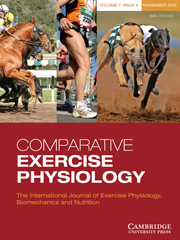Article contents
Feeding management practices and supplement use in top-level event horses
Published online by Cambridge University Press: 01 May 2008
Abstract
The objective of this study was to characterize the nutrition and feeding management practices, including concentrate and supplement use, of three-day event horses prior to and during high-level competition. Subjects were horses competing in one of two divisions at the Jersey Fresh Three-day Event in Allentown, NJ, in 2006 and/or 2007. Body weight and condition score of horses, and feeding management surveys, were completed prior to the start of competition with weight of hay and concentrate taken in 2007. Two sample t-tests were used to compare the data between divisions within each year of the study. For both years, the majority of horses were of the male gender and Thoroughbred breed, aged 11.1 ± 0.3 years. There were no differences between divisions within the year for any of the variables measured. The average numbers of supplements fed on a regular basis to horses competing in the 2006 Concours Complet d'Equitation International (CCI**), 2006 CCI***, 2007 CCI** and 2007 CCI*** events were 4.2 ± 0.4, 4.2 ± 0.3, 4.2 ± 0.5 and 4.3 ± 0.7, respectively. In both years, the most administered type of oral supplement was electrolytes, followed by plain salt and oral joint compounds. The majority of horses in both years did not have any change in their forage and concentrate feeding prior to being transported to the show facility. Feeding practices before and after cross-country varied between years and divisions, but most horses had feed withheld for about 2–4 h prior to the event. The majority of feeding management practices followed research-driven recommendations. However, the relatively high average supplement use per horse raises questions about over-supplementation and/or nutrient interactions in these horses.
Information
- Type
- Research Paper
- Information
- Copyright
- Copyright © Cambridge University Press 2008
References
- 34
- Cited by

